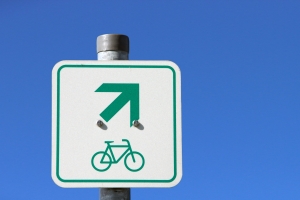- Increases in observed ridership within one year of protected bike lanes' construction ranged from +21% to +171%
- Increases appeared to be greater than overall increases in bicycle commuting in each city
- Increases were made up of 11% new riders, or riders who would not have traveled by bike without the protected lane, and 89% riders who took the route because of the new lane, but would have biked anyway
- 96% of interviewed cyclists felt that the protected lane increased the safety of bicycling on the street
- 79% of residents interviewed felt that the protected lane increased the safety of bicycling on the street
- 43% of people stated that protected bike lanes had made their neighborhoods a more desirable place to live, as opposed to 14% who believed it actually reduced desirability
- 19% of intercepted bicyclists said that they stopped at businesses along the protected bike lane more often than before its installation
- 53% of drivers in communities where protected bike lanes were installed stated that predictability of bicyclists had increased, as opposed to 12% who said it had decreased
- 14% of respondents said that they avoided roads with protected bike lanes installed
- 30-55% of residents stated that impacts to parking were negative; impact to parking was the study's most negative perception
Related Stories
| Aug 11, 2010
PCA partners with MIT on concrete research center
MIT today announced the creation of the Concrete Sustainability Hub, a research center established at MIT in collaboration with the Portland Cement Association (PCA) and Ready Mixed Concrete (RMC) Research & Education Foundation.
| Aug 11, 2010
Best AEC Firms of 2011/12
Later this year, we will launch Best AEC Firms 2012. We’re looking for firms that create truly positive workplaces for their AEC professionals and support staff. Keep an eye on this page for entry information. +
| Aug 11, 2010
AAMA leads development of BIM standard for fenestration products
The American Architectural Manufacturers Association’s newly formed BIM Task Group met during the AAMA National Fall Conference to discuss the need for an BIM standard for nonresidential fenestration products.
| Aug 11, 2010
Call for entries: Building enclosure design awards
The Boston Society of Architects and the Boston chapter of the Building Enclosure Council (BEC-Boston) have announced a High Performance Building award that will assess building enclosure innovation through the demonstrated design, construction, and operation of the building enclosure.
| Aug 11, 2010
Portland Cement Association offers blast resistant design guide for reinforced concrete structures
Developed for designers and engineers, "Blast Resistant Design Guide for Reinforced Concrete Structures" provides a practical treatment of the design of cast-in-place reinforced concrete structures to resist the effects of blast loads. It explains the principles of blast-resistant design, and how to determine the kind and degree of resistance a structure needs as well as how to specify the required materials and details.







